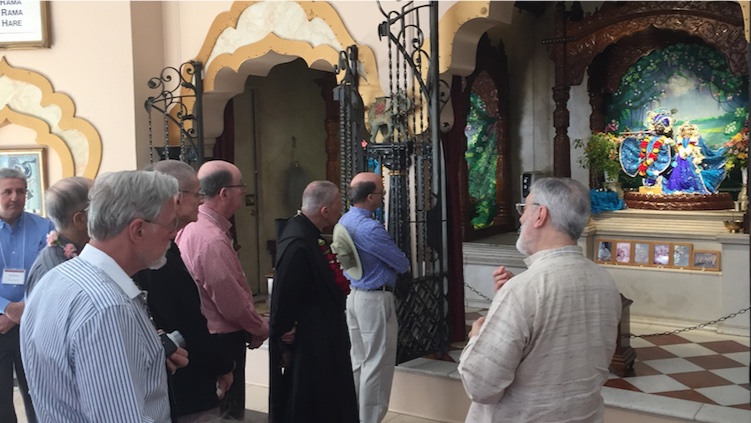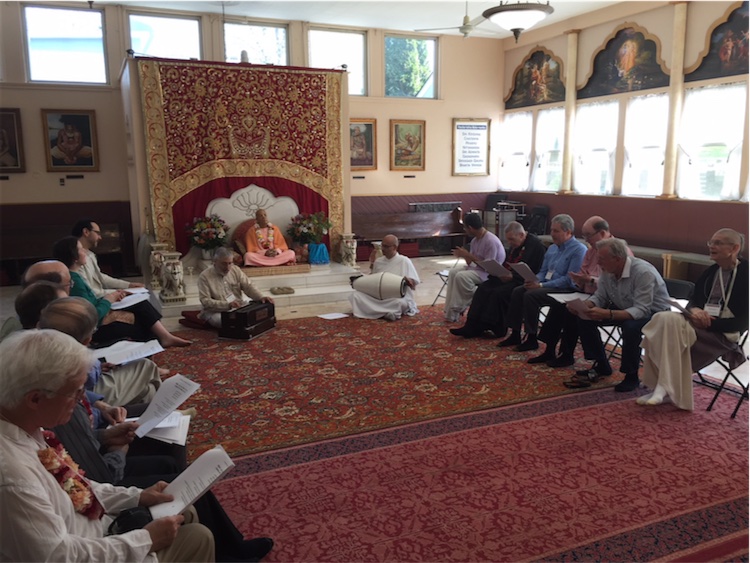Vaishnava-Christian Dialogue Held in Temple for the First Time
By Madhava Smullen | Май 17, 2018

North America’s 21stannual Vaishnava-Christian Dialogue was held on April 13thand 14that the ISKCON of Washington D.C. temple for the first time this spring.
Until now, dialogues have been held in neutral, non-religious spots such as retreat centers and community halls. But with such deep friendships and trust built up over the years, the dialogue was held last year at a Catholic monastery, and this year – for the very first time – at an ISKCON temple.
Twenty-five people attended the dialogue, with a theme this year of “Monasticism from the Vaishnava and Christian Perspectives.”
Christian participants included the Abbot and several monks from a local Catholic monastery, a Protestant minister, a husband and wife team of Christian scholars, and several professors from the Washington D.C. area. A coroner and a sculptor rounded out the varied group.
Among the Vaishnavas were ISKCON Communications Director Anuttama Das and his wife Rukmini Dasi, who founded the dialogue. Joining them were religious studies professor Garuda Das and his wife Krishna Kanta Dasi; Ravindra Svarupa Das, who holds a PhD from Temple University; and Sraddha Dasi, who has a Masters Degree in religious studies from Harvard.
There were also Bayahari Das, chairman of the ISKCON D.C. temple board; Brahmachari Vrajavihari Sharan, a follower of the Nimbarka Vaishnava tradition who serves as Hindu Chaplain at Georgetown University; and Amrita Hari Dasi of ISKCON Communications.
To launch proceedings, representatives from both faiths presented papers. The Abbot presented a very scholarly paper on the role of monasticism within the Catholic Church, and also shared some personal reflections on his four decades of monastic life.

Garuda Das and Brahmachari Vrajavihari lead kirtan as Christian participants follow along with printed verses
In his paper the Abbot discussed private and common prayer; how to make one’s entire day prayer; and the challenges of “the monkey mind” in prayerful life. Of monastic life, he quoted, “The monk in normal circumstances is never alone, a pioneer, a forlorn hope, an apostle. He is one of a family, and of a family that has long and unbroken tradition.”
On behavior, he cited Saint Thérèse of Lisieux, saying, “The ultimate criterion is whether or not we treat others as really being our brothers and sisters in Christ.” He also said that “monks should each try to be the first to show respect to the other, supporting with the greatest patience one another’s weaknesses of body or behavior, and earnestly competing in obedience to one another.”
Brahmachari Vrajavihari Sharan next spoke about the history of monasticism in the Vaishnava tradition, drawing especially from his own Nimbarka tradition – one of the four authorized Vaishanva sampradayas, which traces its origins to the four Kumaras.
After the papers were presented, there was a lively discussion that continued through the first day of the dialogue and into the second.
Topics included the tension that sometimes arises in Vaishnava communities between the grihasta and sannyasa orders, mirrored in the Catholic church by the tension between laypeople and priests.
“That’s something that both traditions need to work on,” Anuttama Das comments, “To ensure that householder and renounced orders maintain a mood of humility and appreciation for each other.”
Also discussed was the Catholic system of gradually increasing one’s vows, with one set of vows after another taken at different stages of advancement.
“I found that of interest, because in ISKCON devotees become brahmacharis, and then later take vows for sannyasa,” says Anuttama. “But we’re also evolving the systems by which people can take sannyasa, adding an annual review, and different other requirements.”
Along with the papers and discussions, the participants shared other activities together. Saturday morning started with a Christian prayer service consisting of hymns and readings. Visitors also got to tour the ISKCON property, see the cows, take darshan of the Deities in the temple room and ask questions about worship of Them.
Meanwhile Rukmini Dasi spoke on her favorite verse from the Srimad-Bhagavatam (5.18.9), in which Prahlad Maharaja shows his character as a true Vaishnava by praying not for himself but for all living entities.
“May there be good fortune throughout the universe, and may all envious persons be pacified,” he says. “May all living entities become calm by practicing bhakti-yoga, for by accepting devotional service they will think of each other’s welfare. Therefore let us all engage in the service of the supreme transcendence, Lord Sri Krsna, and always remain absorbed in thought of Him.”
All participants also honored prasadam catered by the temple for every meal, and followed along with printed verses as Garuda Das and Brahmachari led kirtan of the Hare Krishna maha-mantra and Jaya Radha Madhava.
“The Christian participants loved it so much, and found the atmosphere at the temple very peaceful,” says Amrita Hari. “They all wanted to have it there again, so that’s what we’re going to do next year.”
As usual, according to Amrita, the dialogue ended with everyone developing increased appreciation for the others’ faith.
“There’s always something that you learn, a philosophical point or a touching prayer, that really resonates with you even though it’s not from your own tradition,” she says. “People left inspired, and with increased faith.”
After twenty-one successful years in the U.S., the Vaishnava-Christian dialogue is now spreading to other countries. India’s third annual dialogue, for example, was held at ISKCON’s Tirupati temple in December.
“I wish there was one going on in every country, or even every major city in the world,” says Anuttama. “Because this dialogue not only enriches spiritual growth within the hearts of the participants, but also gives us an opportunity to interact with religious leaders of other communities at a very high level. And it helps them understand the depth and the authenticity of Gaudiya Vaishnavism and the Hare Krishna movement.”















